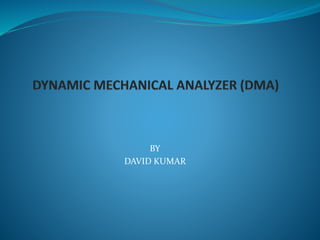
What is DMA? Measuring Dynamic Material Properties
- 2. What is DMA? DMA is a measuring instrument which is used to determine the dynamic characteristics of materials. It applies a dynamic oscillating force to a sample and analyze the material’s response to that cyclic force. Basically, DMA determines changes in sample properties resulting from changes in five experimental variables: temperature, time, frequency, force, and strain.
- 3. Movable frame (main unit) Fixed frame or base Temperature control DMA+450 MODEL Construction of DMA
- 4. Upper part of DMA DMA+450 MODEL
- 5. How does DMA work? The basic principle of this instrument is to exert a dynamic excitation of known amplitude and frequency to a specimen of known dimensions. The measurement of strains and dynamic forces yields the specimen's stiffness. From the known geometry, one can derive mechanical properties of the material, such as modulus and loss factor or damping. The presence of the thermal chamber allows us to perform test at different temperatures and thus determining materials' glass transition temperature.
- 6. Which materials can be analyzed with DMA? DMA instrument can be used to characterize mechanical and/or thermal properties of a great numbers of materials: Polymers Elastomers Composites Metals and metallic alloys Ceramics, glass Adhesives Bitumen (solid and pasty) Paint and varnish (gels or films) Cosmetics (gels, spray….) Oils Biomaterials Leather, skin hair….
- 8. Compression plates Tension jaws for film Tension jaws for bars Tension jaws for bars Plane shear for films Plane shear Shear for liquid Shear for pasty material Dual cantilever Three point bending Grips for Testing on MetraviB DMA
- 9. Viscoelasticity :- Viscoelastic materials exhibit characteristics of both viscous and elastic materials Ex.- Elastomers, polymers etc. Viscosity resistance to flow (damping) Elasticity ability to revert back to original shape Elastic vs viscoelastic response Glass Transition Temperature (Tg) Definition: Transition from bond stretching to long range molecular motion Flow Temperature Definition: point at which heat vibration is enough to break bonds in crystal lattice Theoretical basis for DMA
- 10. Continued…. sinusoidally applied stress measured strain phase lag between applied stress and measured strain Complex dynamic modulus (E*) • Ratio of applied stress to measured strain E* = E’ + iE” = SQRT(E’2+ E”2) Storage modulus (E’) • Energy stored elastically during deformation • “Elastic” of “viscoelastic” • E’= E* cos Loss modulus (E’’) • Energy loss during deformation • “Visco” of “viscoelastic” • E” = E* sin Loss tangent (tan ) or damping or loss factor • shows the ability of material to dissipate the energy • Tan = E’’/E’
- 11. Continued…. If phase lag is zero then E*= E’ material is purely elastic If phase lag is 90 degree then E* = E” material is purely viscous If phase lag is between 0 90 degree then E* = E’ + iE” material is viscoelastic
- 12. 1. Preparation of specimen Depending on the material to analyze, the specimen can be prepared in different ways: Molding, Cutting As a general rule, common specimen dimensions range from a few millimeters to a few centimeters. The use of a caliper is then advised. The use of a micrometer is preferred to measure film thickness. Cutting Venire caliper micrometer Working of DMA
- 13. 2. Selection of specimen holder On the basis of - The nature of the material - specimen shape Correspondence between specimen holder and material of specimen DMA+450 MODEL Materials specimen holder Elastromer (cylinder or bar) compression plates, plane shear Elastomer (band) tension jaws for bars, tension jaws for films, shear jaws for films Polymer compression plates, tension jaws for bars, three point bending, dual cantilever bending, plane shear, shear jaws for films Polymers (films) tension jaws for films, shear jaws for films Polymers (fibers) tension jaws for fibers Pasty bitumen shear for pasty material, shear for liquid materials Metals, metallic alloys, ceramics three point bending, dual cantilever bending
- 14. Continued….. Correspondence between specimen holder and specimen shape DMA+450 MODEL
- 15. 3. Installation of the selected specimen holder 4. Installation of the prepared specimen into the specimen holder inside thermal chamber 5. Start temperature, finish temperature, and step 6. Application of dynamic excitation (stress or strain) on the specimen by dynamic shaker through entire temperature range 7. Then DMA records the response of specimen and determines: E’, E”, Tan 8. Identify transition temperatures based on noticeable changes in curves
- 16. Typical Data from DMA 50 100 150 200 250 300 10 100 1000 Temperature/ o C StorageModulus/MPa LossModulus/MPa TanDelta 10 100 Tg =213 o C 0.0 0.1 0.2 0.3 0.4 0.5 Storage modulus (E’):elastic property Loss modulus (E”) :viscous property Loss tangent (tan ) A typical response from a DMA shows both modulus and Tanδ. As the material goes through its glass transition, the modulus reduces and the Tanδ goes through a peak. Tg indicated by major change in curves: Large drop in log E’ curve and Peak in Tanδ curve
- 17. Sources MetraviB DMA user manual DMA book by Dr. K. P. Menard
- 18. Thank you
